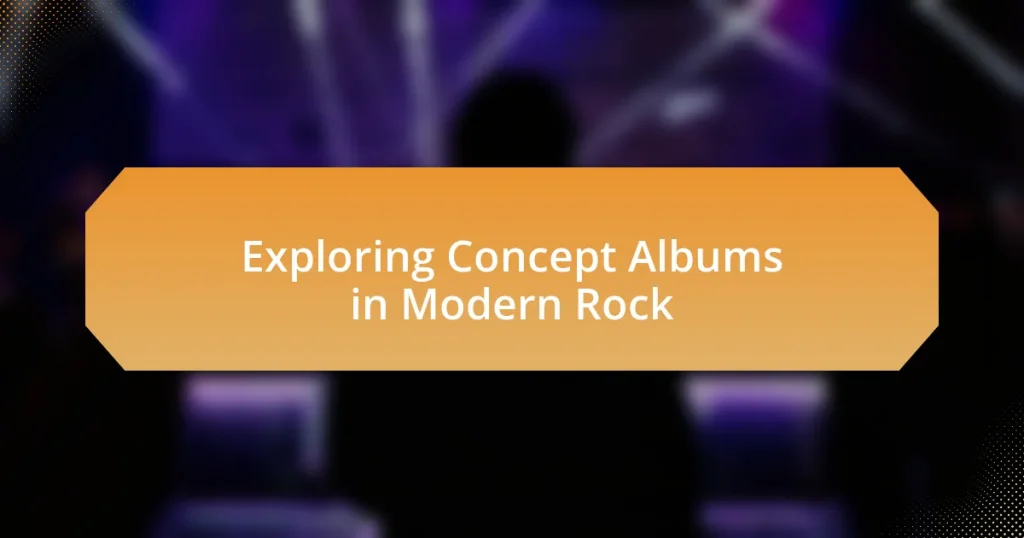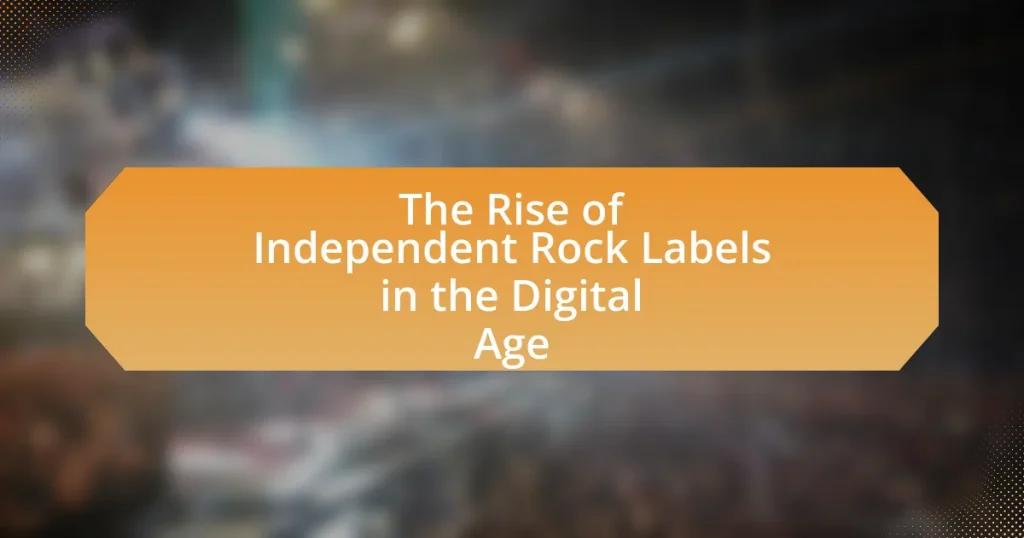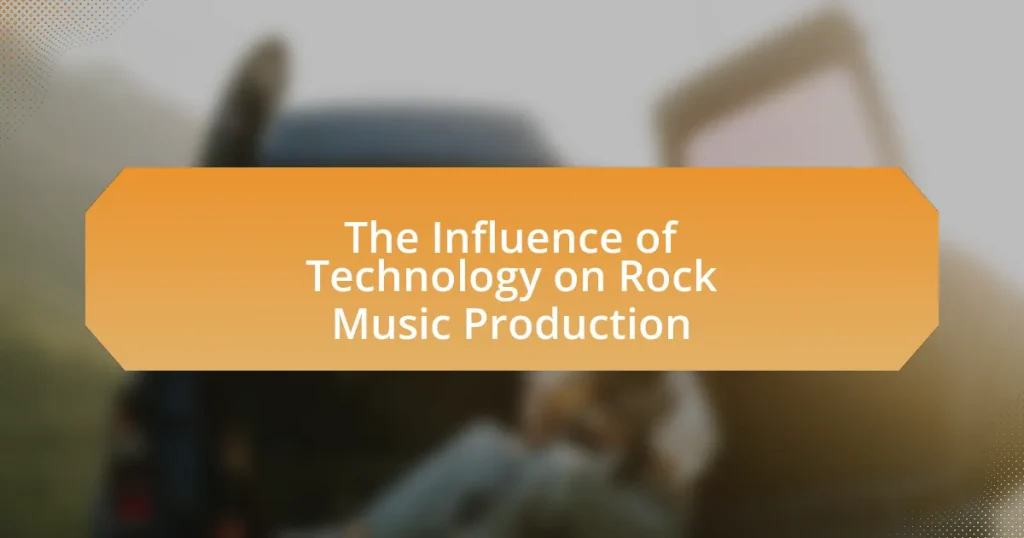Concept albums in modern rock are defined as cohesive works that tell a unified story or explore a central theme throughout the album, distinguishing them from traditional albums that consist of standalone songs. This article examines the characteristics, historical context, and evolution of concept albums, highlighting their significance in modern rock music. It discusses notable examples such as Pink Floyd’s “The Wall” and Green Day’s “American Idiot,” and explores how narratives enhance listener engagement and artistic expression. Additionally, the article addresses the impact of technology on the development of concept albums and their role in reflecting societal issues and shaping musical movements.
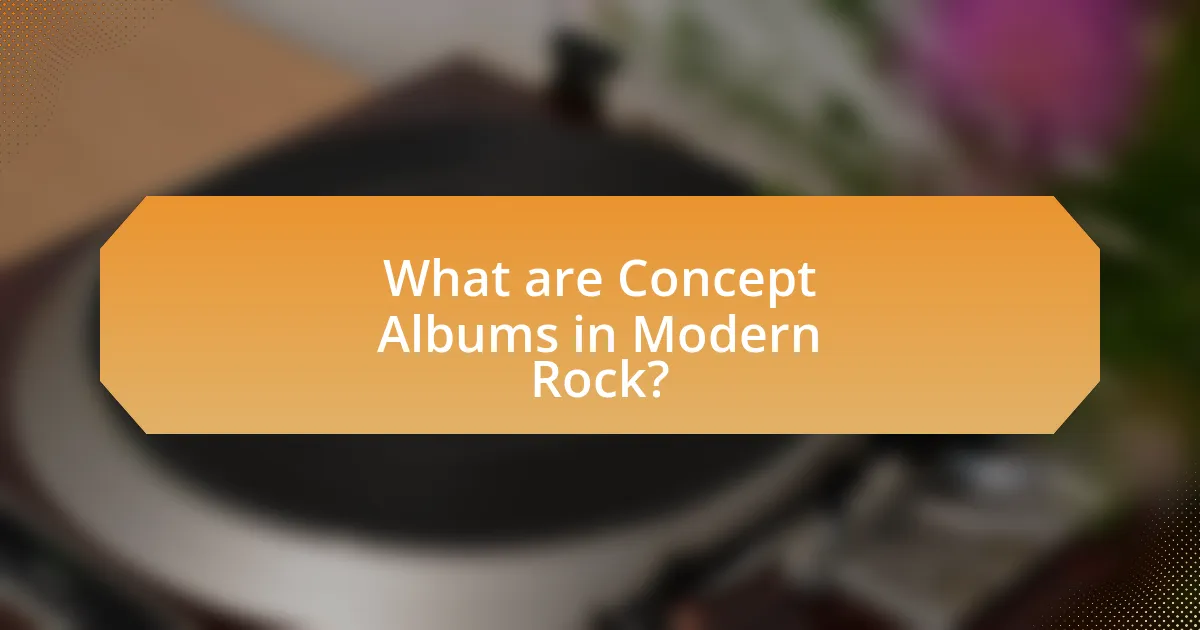
What are Concept Albums in Modern Rock?
Concept albums in modern rock are cohesive works that tell a unified story or explore a central theme throughout the entire album. These albums often feature interconnected songs that contribute to an overarching narrative or concept, allowing for a deeper artistic expression. Notable examples include Pink Floyd’s “The Wall,” which addresses themes of isolation and alienation, and Green Day’s “American Idiot,” which critiques American society and politics. The use of concept albums has become a significant aspect of modern rock, showcasing the genre’s capacity for storytelling and thematic exploration.
How do concept albums differ from traditional albums?
Concept albums differ from traditional albums primarily in their narrative structure and thematic coherence. While traditional albums typically consist of a collection of standalone songs, concept albums are designed around a central theme or story that unfolds throughout the tracks. This approach allows for a more immersive listening experience, as seen in iconic works like Pink Floyd’s “The Wall,” which explores themes of isolation and societal critique through a continuous narrative. The cohesive nature of concept albums often encourages listeners to engage with the music as a unified whole rather than as individual tracks, enhancing the emotional and artistic impact.
What elements define a concept album in modern rock?
A concept album in modern rock is defined by a cohesive narrative or theme that runs throughout the entire album. This narrative often explores complex ideas, emotions, or stories, allowing the songs to interconnect and contribute to a larger artistic statement. For example, Pink Floyd’s “The Wall” presents a continuous storyline about isolation and alienation, illustrating how individual tracks can build upon each other to enhance the overall concept. Additionally, the use of recurring musical motifs and lyrical references throughout the album reinforces the thematic unity, as seen in The Who’s “Tommy,” which tells a singular story through its songs. These elements—narrative cohesion, thematic depth, and musical continuity—are essential in defining a concept album within the modern rock genre.
Why are narratives important in concept albums?
Narratives are important in concept albums because they provide a cohesive storyline that enhances the listener’s experience and engagement with the music. This storytelling aspect allows artists to explore complex themes and emotions, creating a deeper connection between the audience and the material. For example, Pink Floyd’s “The Wall” uses a narrative to address issues of isolation and mental health, which resonates with listeners on multiple levels. By weaving a narrative throughout the album, artists can create a more immersive experience, encouraging listeners to interpret and reflect on the themes presented.
What historical context surrounds concept albums in modern rock?
Concept albums in modern rock emerged as a significant artistic expression during the late 1960s, primarily influenced by the counterculture movement and advancements in recording technology. The Beatles’ “Sgt. Pepper’s Lonely Hearts Club Band,” released in 1967, is often cited as a pioneering example, showcasing a cohesive narrative and thematic unity across tracks. This innovation encouraged other artists, such as Pink Floyd with “The Dark Side of the Moon” in 1973, to explore complex themes and sonic experimentation, solidifying the concept album as a respected format in rock music. The rise of progressive rock further emphasized this trend, with bands like Yes and Genesis creating elaborate musical suites that told stories or conveyed philosophical ideas, reflecting the era’s cultural shifts and artistic aspirations.
How did the concept album evolve over the decades?
The concept album evolved significantly from the 1960s to the 2020s, transitioning from a collection of songs with a loose thematic connection to a cohesive narrative experience. In the 1960s, artists like The Beatles with “Sgt. Pepper’s Lonely Hearts Club Band” and The Who’s “Tommy” pioneered the format, integrating storytelling and thematic depth into their work. The 1970s saw further development with progressive rock bands such as Pink Floyd, whose “The Dark Side of the Moon” presented a unified musical and lyrical journey, achieving both commercial success and critical acclaim.
In the 1980s and 1990s, concept albums became more diverse, with genres like punk and metal adopting the format; for example, Green Day’s “American Idiot” in 2004 addressed social and political themes through a narrative arc. The 2000s and 2010s witnessed a resurgence of the concept album in various genres, including hip-hop, with artists like Kendrick Lamar in “To Pimp a Butterfly” using the format to explore complex themes of identity and society.
By the 2020s, the concept album has become a versatile tool for artists across genres, often incorporating multimedia elements and digital storytelling, reflecting the changing landscape of music consumption and artistic expression. This evolution illustrates the concept album’s adaptability and enduring relevance in modern rock and beyond.
What role did technology play in the development of concept albums?
Technology played a crucial role in the development of concept albums by enabling artists to experiment with sound and structure in ways that were previously impossible. The advent of multi-track recording in the 1960s allowed musicians to layer instruments and vocals, creating complex soundscapes that supported narrative themes. For instance, Pink Floyd’s “The Dark Side of the Moon,” released in 1973, utilized advanced studio techniques to weave together songs into a cohesive story, showcasing how technology facilitated artistic expression. Additionally, the introduction of synthesizers and digital effects expanded the sonic palette available to artists, further enhancing the storytelling aspect of concept albums. This technological evolution not only transformed the production process but also influenced the way listeners engaged with music, as albums became immersive experiences rather than just collections of songs.
Why are concept albums significant in the modern rock genre?
Concept albums are significant in the modern rock genre because they allow artists to explore complex themes and narratives, creating a cohesive listening experience. This format encourages deeper engagement from listeners, as seen in albums like Pink Floyd’s “The Wall” and Green Day’s “American Idiot,” which both address social and political issues through storytelling. The success of these albums demonstrates that concept-driven music can resonate widely, influencing both artistic expression and commercial viability in the rock genre.
What impact do concept albums have on artistic expression?
Concept albums significantly enhance artistic expression by allowing artists to explore complex themes and narratives cohesively. This format encourages musicians to create a unified body of work that transcends individual songs, enabling deeper storytelling and emotional engagement. For instance, Pink Floyd’s “The Wall” intricately weaves personal and societal themes, illustrating how concept albums can serve as a platform for profound artistic exploration. Additionally, research indicates that concept albums often lead to increased listener engagement, as audiences are drawn into the overarching narrative, fostering a more immersive experience. This impact on artistic expression is evident in the way artists like The Who and Radiohead have utilized the concept album format to challenge conventional songwriting and push creative boundaries.
How do concept albums influence listener engagement?
Concept albums significantly enhance listener engagement by creating a cohesive narrative that encourages deeper emotional and intellectual investment. This format allows listeners to experience a unified story or theme across multiple tracks, fostering a sense of connection and immersion. Research indicates that albums like Pink Floyd’s “The Wall” and The Who’s “Tommy” have not only achieved commercial success but also cultivated dedicated fan bases due to their intricate storytelling and thematic depth. Such engagement is further supported by studies showing that listeners are more likely to revisit and discuss albums that present a compelling narrative, thus increasing their overall connection to the music and the artist.
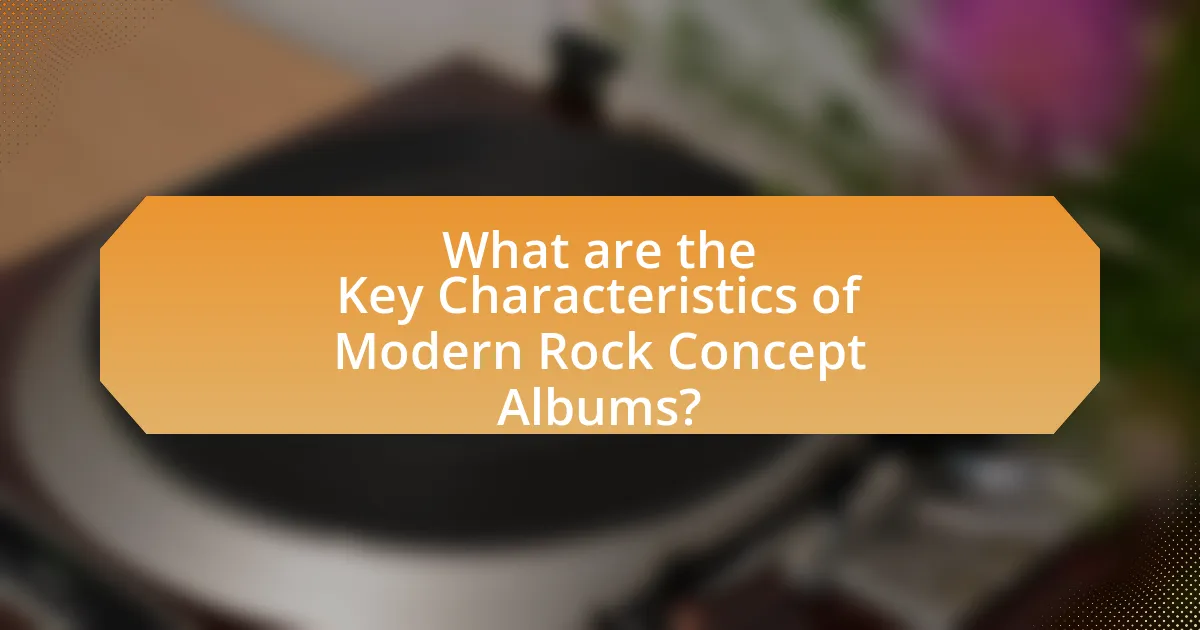
What are the Key Characteristics of Modern Rock Concept Albums?
Modern rock concept albums are characterized by a cohesive narrative or thematic structure that connects the songs, creating a unified listening experience. This narrative often explores complex themes such as identity, societal issues, or personal struggles, allowing for deeper emotional engagement. Additionally, modern rock concept albums frequently incorporate diverse musical styles and innovative production techniques, enhancing the storytelling aspect. For instance, albums like “The Wall” by Pink Floyd and “American Idiot” by Green Day exemplify how narrative-driven lyrics and varied instrumentation can elevate the concept album format, making it a significant artistic expression in contemporary music.
How do themes and narratives shape modern rock concept albums?
Themes and narratives are fundamental in shaping modern rock concept albums by providing a cohesive storyline that enhances the listening experience. These elements allow artists to explore complex ideas, emotions, and social issues, creating a deeper connection with the audience. For instance, Pink Floyd’s “The Wall” addresses themes of isolation and mental health, which resonate with listeners and elevate the album’s impact. Additionally, contemporary bands like Coheed and Cambria utilize intricate narratives that span multiple albums, engaging fans in a larger fictional universe. This storytelling approach not only enriches the music but also encourages listeners to engage with the album on multiple levels, fostering a sense of community and shared interpretation among fans.
What common themes are explored in contemporary concept albums?
Contemporary concept albums commonly explore themes such as identity, mental health, societal issues, and personal relationships. These themes are often interwoven to create a cohesive narrative throughout the album. For instance, albums like “To Pimp a Butterfly” by Kendrick Lamar delve into racial identity and systemic oppression, while “The Wall” by Pink Floyd addresses isolation and mental health struggles. Such thematic depth allows artists to engage listeners on multiple levels, making the albums not just collections of songs but comprehensive storytelling experiences.
How do artists convey their narratives through music and lyrics?
Artists convey their narratives through music and lyrics by utilizing storytelling techniques, thematic coherence, and emotional resonance. In concept albums, musicians often create a cohesive storyline that unfolds across multiple tracks, allowing listeners to engage with a larger narrative arc. For example, Pink Floyd’s “The Wall” explores themes of isolation and mental anguish, with each song contributing to the overarching story of the protagonist’s descent into despair. This method of integrating lyrics with musical composition enhances the emotional impact and helps listeners connect with the narrative on a deeper level. Additionally, artists often employ literary devices such as metaphor, imagery, and character development within their lyrics to enrich the storytelling experience, making the narrative more relatable and immersive.
What musical techniques are often used in concept albums?
Concept albums often utilize techniques such as thematic continuity, recurring motifs, and narrative structures to create a cohesive listening experience. Thematic continuity allows the album to explore a central idea or story throughout its tracks, while recurring motifs, such as specific musical phrases or lyrical themes, reinforce this central concept. Additionally, narrative structures can guide the listener through a storyline, often employing varied musical styles to reflect different parts of the narrative. For example, Pink Floyd’s “The Wall” employs these techniques to convey a complex story about isolation and alienation, demonstrating how musical elements can enhance the thematic depth of a concept album.
How do transitions and interludes enhance the listening experience?
Transitions and interludes enhance the listening experience by creating a seamless flow between songs and reinforcing thematic elements within a concept album. These musical segments serve as bridges that connect different tracks, allowing listeners to engage more deeply with the narrative and emotional journey of the album. For instance, in Pink Floyd’s “The Wall,” interludes like “The Happiest Days of Our Lives” transition into “Another Brick in the Wall, Part 2,” effectively maintaining the album’s storyline and emotional intensity. This technique not only keeps the listener immersed but also emphasizes the overarching themes, making the listening experience more cohesive and impactful.
What role do instrumentation and production play in concept albums?
Instrumentation and production are crucial in concept albums as they enhance the narrative and emotional depth of the music. The choice of instruments and their arrangement can create specific atmospheres that align with the album’s themes, while production techniques, such as layering and effects, help to weave a cohesive sonic tapestry. For instance, Pink Floyd’s “The Wall” utilizes orchestral elements and sound effects to amplify its storytelling, demonstrating how instrumentation and production can elevate the listener’s experience and reinforce the overarching concept.
What are some notable examples of modern rock concept albums?
Notable examples of modern rock concept albums include “The Wall” by Pink Floyd, “American Idiot” by Green Day, and “The Hazards of Love” by The Decemberists. “The Wall,” released in 1979, is a rock opera that explores themes of isolation and personal trauma, solidifying its status as a classic. “American Idiot,” released in 2004, critiques American society and politics, resonating with a generation and achieving significant commercial success. “The Hazards of Love,” released in 2009, tells a narrative of love and tragedy, showcasing The Decemberists’ storytelling prowess. These albums exemplify the concept album format in modern rock, combining narrative depth with musical innovation.
Which artists are known for their influential concept albums?
Artists known for their influential concept albums include Pink Floyd, The Who, and David Bowie. Pink Floyd’s “The Wall” is a seminal work that explores themes of isolation and societal pressure, while The Who’s “Tommy” is recognized as one of the first rock operas, telling a cohesive story through its tracks. David Bowie’s “The Rise and Fall of Ziggy Stardust and the Spiders from Mars” presents a narrative about an androgynous rock star, blending music with a theatrical storyline. These albums have significantly impacted the genre, shaping the way artists approach storytelling in music.
What makes these albums stand out in the modern rock landscape?
These albums stand out in the modern rock landscape due to their cohesive storytelling and innovative soundscapes. Concept albums often explore complex themes and narratives, allowing artists to create a more immersive listening experience. For instance, albums like “The Dark Side of the Moon” by Pink Floyd and “American Idiot” by Green Day have been recognized for their ability to weave intricate stories through music, which resonates deeply with audiences. Additionally, the use of diverse musical styles and production techniques in these albums enhances their uniqueness, making them memorable in a genre that often prioritizes singles over full narratives.
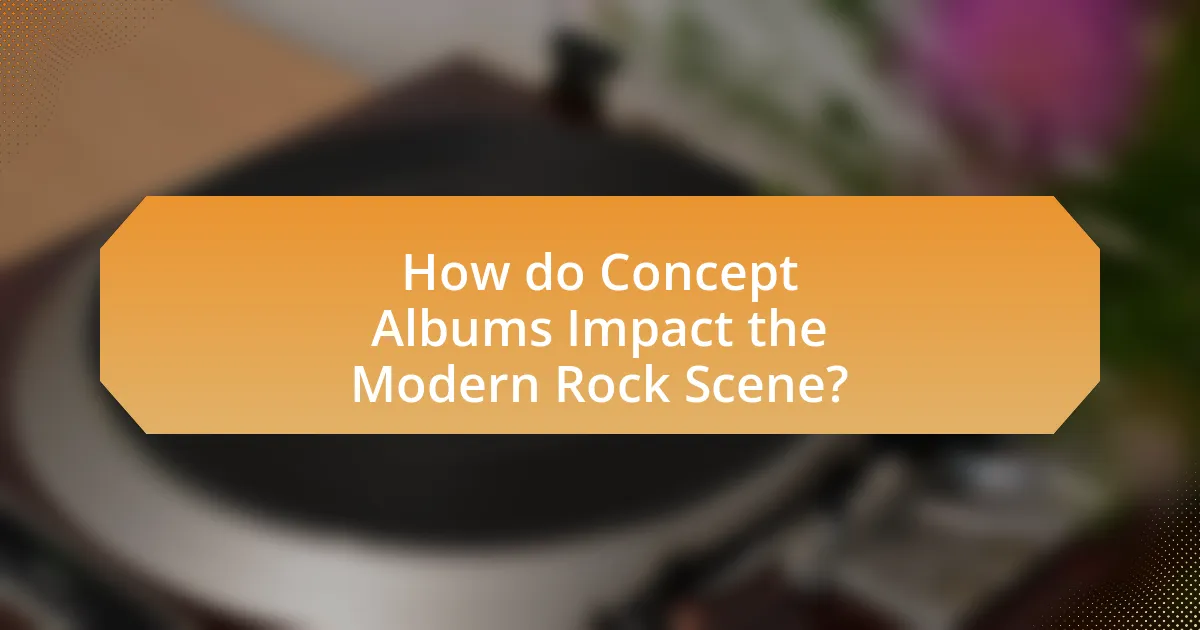
How do Concept Albums Impact the Modern Rock Scene?
Concept albums significantly influence the modern rock scene by providing a cohesive narrative that enhances the listening experience. This format allows artists to explore complex themes and emotions, creating a deeper connection with their audience. For instance, Pink Floyd’s “The Wall” and Green Day’s “American Idiot” exemplify how storytelling can elevate music beyond mere entertainment, often addressing social and political issues. Additionally, concept albums can lead to innovative musical experimentation, as seen in the works of bands like Coheed and Cambria, which blend various genres to support their narratives. The resurgence of interest in vinyl and immersive listening experiences has further fueled the popularity of concept albums, making them a relevant and impactful aspect of contemporary rock music.
What are the cultural implications of concept albums in modern rock?
Concept albums in modern rock serve as a medium for artists to explore complex narratives and themes, reflecting societal issues and personal experiences. These albums often challenge traditional song structures, allowing for deeper storytelling and emotional engagement, which resonates with listeners on multiple levels. For instance, Pink Floyd’s “The Wall” addresses themes of isolation and mental health, influencing cultural conversations around these topics. Additionally, the rise of streaming platforms has facilitated the consumption of concept albums, enabling artists to reach wider audiences and fostering a community of listeners who appreciate cohesive artistic statements. This shift has led to a resurgence of interest in narrative-driven music, highlighting the evolving relationship between art and culture in contemporary society.
How do concept albums reflect societal issues and trends?
Concept albums reflect societal issues and trends by weaving narratives that address contemporary themes, such as political unrest, social justice, and personal identity. For instance, Pink Floyd’s “The Wall” critiques the alienation and disillusionment experienced in modern society, resonating with listeners during the socio-political upheaval of the 1970s. Similarly, Kendrick Lamar’s “To Pimp a Butterfly” explores racial inequality and personal struggle, mirroring the Black Lives Matter movement and its impact on American culture. These albums serve as cultural commentaries, encapsulating the zeitgeist of their respective eras and prompting listeners to engage with pressing societal concerns.
What role do concept albums play in shaping musical movements?
Concept albums play a crucial role in shaping musical movements by providing a cohesive narrative that unifies songs, thus influencing the artistic direction of genres. For instance, Pink Floyd’s “The Wall” not only defined progressive rock but also set a precedent for storytelling in music, encouraging artists to explore complex themes and concepts. This approach has led to the emergence of subgenres, such as rock opera, which further expanded the boundaries of musical expression. Additionally, concept albums often reflect cultural and social issues, as seen in Green Day’s “American Idiot,” which resonated with the political climate of the early 2000s, demonstrating how these albums can galvanize movements and inspire collective action among listeners.
How do fans and critics perceive concept albums in modern rock?
Fans and critics generally perceive concept albums in modern rock as ambitious artistic statements that showcase a band’s creativity and storytelling ability. This perception is supported by the fact that successful concept albums, such as “The Wall” by Pink Floyd and “American Idiot” by Green Day, have received critical acclaim and commercial success, indicating that audiences appreciate cohesive narratives and thematic depth. Critics often highlight the complexity and emotional engagement of these albums, while fans tend to celebrate the immersive experience they provide, reinforcing the idea that concept albums can elevate the rock genre beyond traditional song structures.
What are the common criticisms of concept albums?
Common criticisms of concept albums include their perceived lack of accessibility, as listeners may find it challenging to engage with a narrative structure that requires full attention. Critics argue that this complexity can alienate casual listeners who prefer standalone tracks. Additionally, some concept albums are criticized for prioritizing thematic coherence over musical diversity, leading to monotonous soundscapes that may not appeal to a broader audience. Furthermore, the ambition of a cohesive story can result in uneven pacing, where certain sections feel drawn out or underdeveloped, detracting from the overall listening experience. These criticisms highlight the tension between artistic ambition and listener engagement in the realm of concept albums.
How do fans engage with concept albums compared to traditional albums?
Fans engage with concept albums more deeply than traditional albums due to the narrative structure and thematic coherence that concept albums provide. This engagement often involves active listening, where fans seek to understand the overarching story or message conveyed throughout the album, as opposed to the more casual listening experience typically associated with traditional albums, which may consist of standalone tracks. Research indicates that concept albums, such as Pink Floyd’s “The Wall” or The Who’s “Tommy,” encourage fans to explore lyrics, artwork, and accompanying media, fostering a community of discussion and interpretation among listeners. This heightened engagement is evidenced by the prevalence of fan forums and analyses dedicated to dissecting the intricate details of concept albums, demonstrating a commitment to understanding the artist’s vision.
What are some best practices for creating a successful concept album?
To create a successful concept album, artists should focus on a cohesive narrative that connects each song, ensuring thematic consistency throughout the project. This involves developing a clear storyline or concept that resonates with listeners, allowing them to engage deeply with the music. Additionally, artists should consider the arrangement of tracks to enhance the flow of the album, creating transitions that maintain listener interest and emotional engagement.
Incorporating varied musical styles and instrumentation can also enrich the listening experience, providing dynamic contrasts that reflect the narrative’s progression. Collaborating with other musicians or producers can introduce fresh perspectives and ideas, further enhancing the album’s depth.
Successful concept albums often include visual elements, such as artwork and music videos, that complement the music and reinforce the overarching theme. For instance, Pink Floyd’s “The Wall” effectively uses visual storytelling to enhance its narrative, demonstrating the power of multimedia in concept albums.
Ultimately, thorough planning and a clear vision are essential for artists aiming to create a compelling and memorable concept album.
How can artists effectively develop a cohesive narrative?
Artists can effectively develop a cohesive narrative by establishing a clear theme and structure throughout their work. This involves creating a storyline that connects individual songs, ensuring that each piece contributes to the overall message or concept. For instance, Pink Floyd’s “The Wall” exemplifies this approach, as it tells a continuous story of isolation and personal struggle, with each track building on the narrative arc. Additionally, artists can use recurring motifs, lyrical callbacks, and consistent musical styles to reinforce the narrative, as seen in The Who’s “Tommy,” which integrates various musical elements to support its storyline. By focusing on these techniques, artists can create a unified and engaging listening experience that resonates with audiences.
What strategies can musicians use to enhance listener engagement?
Musicians can enhance listener engagement by incorporating storytelling elements into their music, particularly through concept albums. Concept albums, which are cohesive works that revolve around a central theme or narrative, allow musicians to create a deeper emotional connection with their audience. For instance, Pink Floyd’s “The Wall” effectively uses a narrative structure to explore complex themes of isolation and societal pressure, resulting in heightened listener investment. Additionally, musicians can engage listeners by utilizing interactive platforms, such as social media and live streaming, to foster a sense of community and direct communication. Research indicates that artists who actively engage with their audience on social media see increased loyalty and fan interaction, as evidenced by a study published in the Journal of Music and Social Media, which found that 70% of fans feel more connected to artists who share personal insights online.
